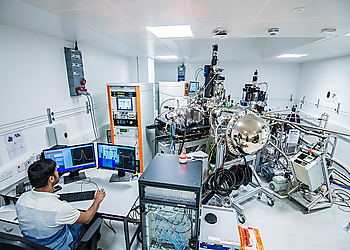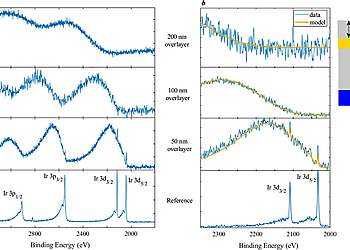Inelastic Background Modelling Applied to Hard X-ray Photoelectron Spectroscopy of Deeply Buried Layers
Result of the Month
A Comparison of Synchrotron and Lab-based (9.25 keV) Measurements
Personal Note of the Author
We were delighted to obtain the world’s first HAXPES lab system from Scienta Omicron for the Henry Royce Institute in the UK, using a Ga 9.25 keV anode with high enough intensity to make measurements quickly. This opens up analysis of buried layers, layered structures, as well as materials systems with rough and contaminated surfaces, such as batteries. We wanted to quantify atomic concentrations and gauge exactly how deep below the surface we can extract information from, which lead to our collaboration with Prof Tougaard at the University of Southern Denmark. We found it remarkable that we can extract information from up to 20 times the inelastic mean free path of the electron, which translates to hundreds of nanometres for these organic LED materials. We have now generated a library of sensitivity factors for this X-ray source which for easy quantification of every element and every core level, and as such the interest in applying HAXPES for non-destructive chemical composition analysis below the surface is greatly accelerating.
Authors
B.F. Spencer a,b,*, S. Maniyarasu c,d, B.P. Reed e, D.J.H. Cant e, R. Ahumada-Lazo c,d, A. G. Thomas a,d, C.A. Muryn d,f, M. Maschek g, S.K. Eriksson g, T. Wiell g, T.-L. Lee h, S. Tougaard i, A.G. Shard e, W.R. Flavell b,c,d
Institutes
a Department of Materials, The University of Manchester, Oxford Road, Manchester, United Kingdom
b Sir Henry Royce Institute for Advanced Materials, The University of Manchester, Oxford Road, Manchester, United Kingdom
c Department of Physics and Astronomy, The University of Manchester, Oxford Road, Manchester, United Kingdom
d The Photon Science Institute, The University of Manchester, Oxford Road, Manchester, United Kingdom
e National Physical Laboratory, Hampton Road, Teddington, United Kingdom
f Department of Chemistry, The University of Manchester, Oxford Road, Manchester, United Kingdom
g Scienta Omicron GmbH, Limburger Strasse 75, Taunusstein, Germany
h Diamond Light Source Ltd, Harwell Science and Innovation Campus, Didcot, United Kingdom
i Department of Physics, Chemistry and Pharmacy, University of Southern Denmark, DK-5230 Odense M, Denmark
URL of Institute web-pages
https://www.manchester.ac.uk/
Publication(s)
Applied Surface Science 541 (2021) 148635
https://doi.org/10.1016/j.apsusc.2020.148635
Instrument
HAXPES Lab with Ga source and EW4000 at Diamond Light Source (BL I09)


